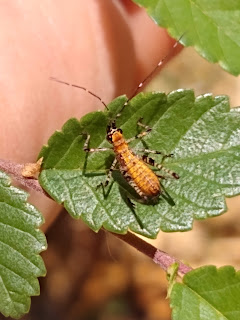Up in the high desert, the quail are also protecting young, and territtory, but mostly from other quail. The males perch on prominent spots and call loudly to advertise their presence.
Pollinators are super important for high desert plants that are otherwise isolated from each other. This bee fly is not exclusive to this flower, however. In the wetlands areas there are some insects that will only land on one specific flower, and these symbiosis are critical to both species survival. The link has a great blog article for the Xerces society, a nonprofit group that focuses on pollinators.
This picture shows the caterpillar of a beetle. It also shows the gall of a wasp's nest on the left. The wasp produces hormones that causes the plant to grow a nest chamber around the wasp eggs.
I think this insect is some sort of katydid, but the jury is still out
Roses are amazingly adaptable plants. This flower is a species of rock rose, very distinct and cultivated for dry conditions. The flower only blooms for 1 day, but the plant seems to always have one bloom open.
This plant is an Ephedra genus. "Mormon tea" is a stimulant and banned dietary aid. I have seen the bizarre effects it can have on some people.
Flowers come in many types and flavors, this is an "inflorescence" a whole cluster of tiny flowers
These common plants are called milkvetches. It can cause a disease called "Locoism" and in bad cases causes permanent neurological disease in browsers like horses.
While cleaning the ditches by the elementary school of human caused trash I was able to examine the ground closely. The soil is damp and full of roots, woodlouse, and land snails, great indicators of moisture. The long grasses
I was surprised to find cottonwoods thriving in the shade of the russian olives. They seem very happy growing in this ditch. The roots are clearly able to reach into the water table
Also surprising was the cattails growing up through the grass. They usually indicate low oxygen soils
I am hunting the sand dunes for a specific type of grass. The problem is many plants look similar to the untrained eye. However, 80 degrees and full sun is great at motivating a person to find what they are looking for quickly!
These leaves belong to the mustard family and look crazy to me. I think they are seed pods, but am unsure. they should be leaves...
This is scorpion weed. The myth is they are used to relieve scorpion stings. Not going to recommend this myself. They are some of the first plants to colonize disturbed full full ground. They also seem to be among the first to flower.
Dimorphocarpa. There doesn't seem to be much in the literature on this plant. But I am not anywhere near a flower expert. Working on it.
The pale circle in the picture center is the eye of this very old turtle. It seems to be having very deep turtle thoughts.
This nose is pivitol to the frog hunting this big turtle is doing right now. Often these turtles will scavenge carrion, but they are hunters too. You can often see frogs and ducks with cuts from close encounters with these ambush hunters.
I am not sure what would cause these round punctures in the turtle shell. I have opinions, but should probably keep those to myself for the time being.




















No comments:
Post a Comment